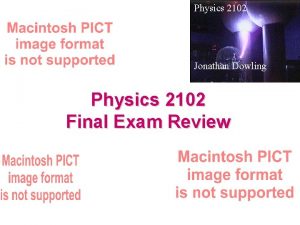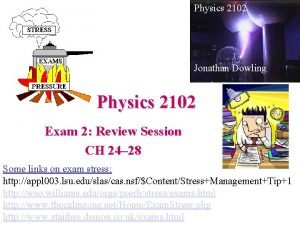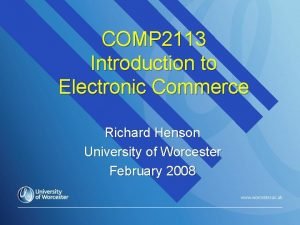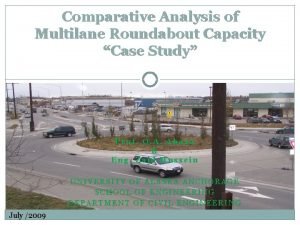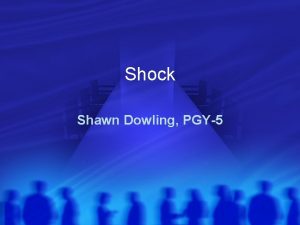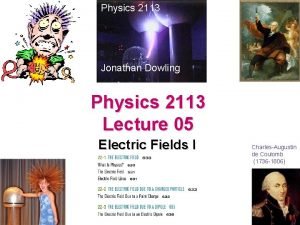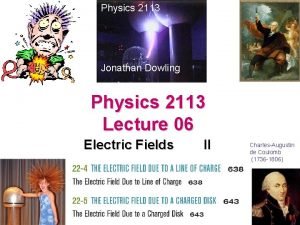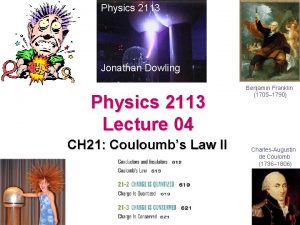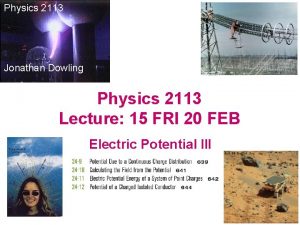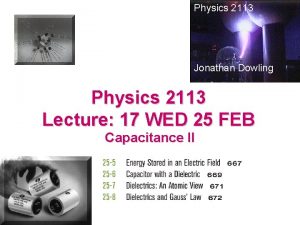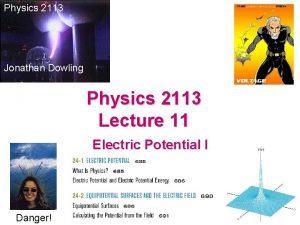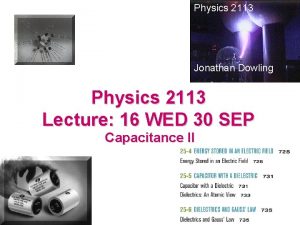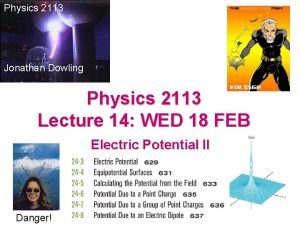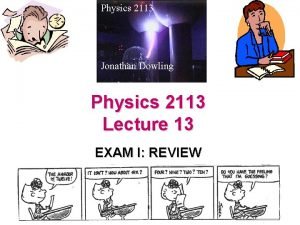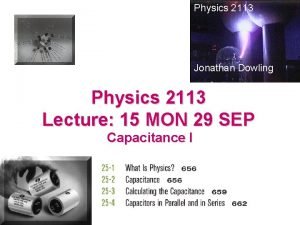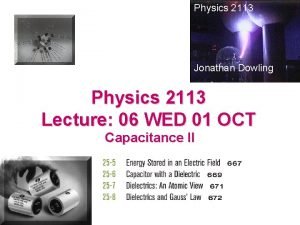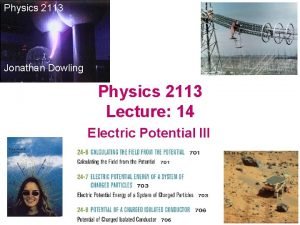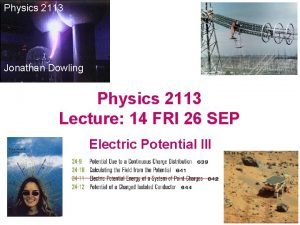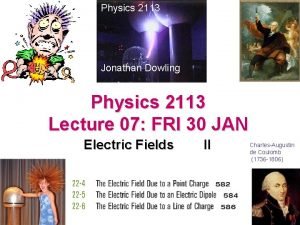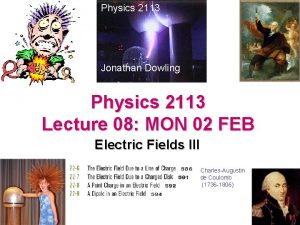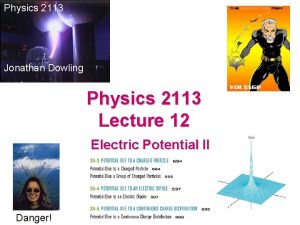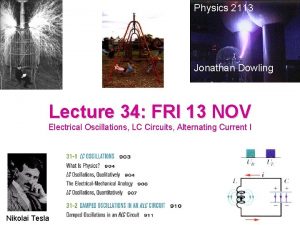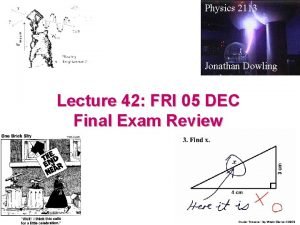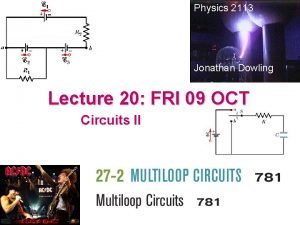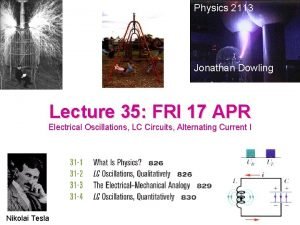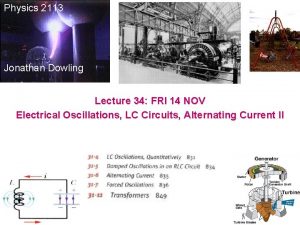Physics 2113 Jonathan Dowling Lecture 18 FRI 27























- Slides: 23

Physics 2113 Jonathan Dowling Lecture 18 FRI 27 FEB Exam 2: Review Session CH 23, 24, 25 / HW 04, 05, 06 Some links on exam stress: http: //appl 003. lsu. edu/slas/cas. nsf/$Content/Stress+Management+Tip+1 http: //wso. williams. edu/orgs/peerh/stress/exams. html http: //www. thecalmzone. net/Home/Exam. Stress. php http: //www. staithes. demon. co. uk/exams. html

Exam 2 • (Ch 23) Gauss’s Law • (Ch 24) Sec. 11 (Electric Potential Energy of a System of Point Charges); Sec. 12 (Potential of Charged Isolated Conductor) • (Ch 25) Capacitors: capacitance and capacitors; caps in parallel and in series, dielectrics; energy, field and potential in capacitors.

• Gauss’ law: Φ=q/ε 0. Given the field, what is the charge enclosed? Given the charges, what is the flux? Use it to deduce formulas for electric field. • Electric potential: • • • – What is the potential produced by a system of charges? (Several point charges, or a continuous distribution) Electric field lines, equipotential surfaces: lines go from +ve to –ve charges; lines are perpendicular to equipotentials; lines (and equipotentials) never cross each other… Electric potential, work and potential energy: work to bring a charge somewhere is W = –q. V (signs!). Potential energy of a system = negative work done to build it. Conductors: field and potential inside conductors, and on the surface. Shell theorem: systems with spherical symmetry can be thought of as a single point charge (but how much charge? ) Symmetry, and “infinite” systems.

Gauss’ law At each point on the surface of the cube shown in Fig. 24 -26, the electric field is in the z direction. The length of each edge of the cube is 2. 3 m. On the top surface of the cube E = -38 k N/C, and on the bottom face of the cube E = +11 k N/C. Determine the net charge contained within the cube. [-2. 29 e-09] C

Gauss’s Law: Cylinder, Plane, Sphere

Problem: Gauss’ Law to Find E

Gauss’ law A long, non conducting, solid cylinder of radius 4. 1 cm has a nonuniform volume charge density that is a function of the radial distance r from the axis of the cylinder, as given by r = Ar 2, with A = 2. 3 µC/m 5. (a)What is the magnitude of the electric field at a radial distance of 3. 1 cm from the axis of the cylinder? (b)What is the magnitude of the electric field at a radial distance of 5. 1 cm from the axis of the cylinder?

The figure shows conducting plates with area A=1 m 2, and the potential on each plate. Assume you are far from the edges of the plates. • What is the electric field between the plates in each case? • What (and where) is the charge density on the plates in case (1)? • What happens to an electron released midway between the plates in case (1)?

Electric potential, electric potential energy, work In Fig. 25 -39, point P is at the center of the rectangle. With V = 0 at infinity, what is the net electric potential in terms of q/d at P due to the six charged particles?

Derive an expression in terms of q 2/a for the work required to set up the four-charge configuration of Fig. 25 -50, assuming the charges are initially infinitely far apart. The electric potential at points in an xy plane is given by V = (2. 0 V/m 2)x 2 - (4. 0 V/m 2)y 2. What are the magnitude and direction of the electric field at point (3. 0 m, 3. 0 m)?

Potential Energy of A System of Charges • 4 point charges (each +Q) are connected by strings, forming a square of side L • If all four strings suddenly snap, what is the kinetic energy of each charge when they are very far apart? • Use conservation of energy: – Final kinetic energy of all four charges = initial potential energy stored = energy required to assemble the system of charges +Q +Q Do this from scratch! Don’t memorize the formula in the book! We will change the numbers!!!

Potential Energy of A System of Charges: Solution • No energy needed to bring in first charge: U 1=0 +Q +Q • Energy needed to bring in 2 nd charge: • Energy needed to bring in 3 rd charge = • Energy needed to bring in 4 th charge = Total potential energy is sum of all the individual terms shown on left hand side = So, final kinetic energy of each charge =

Potential V of Continuous Charge Distributions Straight Line Charge: dq=λ dx λ =Q/L Curved Line Charge: dq=λ ds λ =Q/2π R Surface Charge: dq=σ d. A σ =Q/π R 2 d. A=2π R’d. R’

Potential V of Continuous Charge Distributions Curved Line Charge: dq=λ ds λ =Q/2π R Straight Line Charge: dq=λ dx λ =Q/L

Potential V of Continuous Charge Distributions Surface Charge: dq=σ d. A σ =Q/π R 2 d. A=2πR’d. R‘ Straight Line Charge: dq=λ dx λ =bx is given to you.

Capacitors E = σ/ε 0 = q/Aε 0 E =Vd q=CV Cplate = ε 0 A/d Connected to Battery: V=Constant Disconnected: Q=Constant Cplate = κ ε 0 A/d Csphere=ε 0 ab/(b-a)

Isolated Parallel Plate Capacitor: ICPP • • • A parallel plate capacitor of capacitance C is charged using a battery. Charge = Q, potential voltage difference = V. Battery is then disconnected. If the plate separation is INCREASED, does the capacitance C: • Q is fixed! (a) Increase? • d increases! (b) Remain the same? • C decreases (= ε 0 A/d) (c) Decrease? • V=Q/C; V increases. If the plate separation is INCREASED, does the Voltage V: (a) Increase? (b) Remain the same? (c) Decrease? +Q –Q

Parallel Plate Capacitor & Battery: ICPP • A parallel plate capacitor of capacitance C is charged using a battery. • Charge = Q, potential difference = V. • Plate separation is INCREASED while battery remains connected. • V is fixed constant by battery! Does the Electric Field Inside: • C decreases (=ε A/d) 0 (a) Increase? • Q=CV; Q decreases • E = σ/ε 0 = Q/ε 0 A decreases (b) Remain the Same? (c) Decrease? Battery does work on capacitor to maintain constant V! +Q –Q

Capacitors Q=CV In series: same charge 1/Ceq= ∑ 1/Cj In parallel: same voltage Ceq=∑Cj

Capacitors in Series and in Parallel • What’s the equivalent capacitance? • What’s the charge in each capacitor? • What’s the potential across each capacitor? • What’s the charge delivered by the battery?

Capacitors: Checkpoints, Questions


 E=q/ae0
E=q/ae0 Jonathan dowling
Jonathan dowling Comp 2113
Comp 2113 Art 2113 cc
Art 2113 cc Afi 36 2113
Afi 36 2113 Dowling optical
Dowling optical Dowling roundabout
Dowling roundabout International human resource management dowling 6th edition
International human resource management dowling 6th edition Shock mnemonic
Shock mnemonic 01:640:244 lecture notes - lecture 15: plat, idah, farad
01:640:244 lecture notes - lecture 15: plat, idah, farad Physics 101 lecture notes pdf
Physics 101 lecture notes pdf Phy101 lecture 1
Phy101 lecture 1 Physics 101 lecture notes pdf
Physics 101 lecture notes pdf Physics 111 lecture notes
Physics 111 lecture notes Atmospheric physics lecture notes
Atmospheric physics lecture notes Wave notes
Wave notes Why does it happen
Why does it happen University physics with modern physics fifteenth edition
University physics with modern physics fifteenth edition Good physics ia topics
Good physics ia topics Mon tue wed thur fri sat sun
Mon tue wed thur fri sat sun Mon tues
Mon tues Mon to thurs
Mon to thurs Mon to thurs
Mon to thurs Sun-thu
Sun-thu
